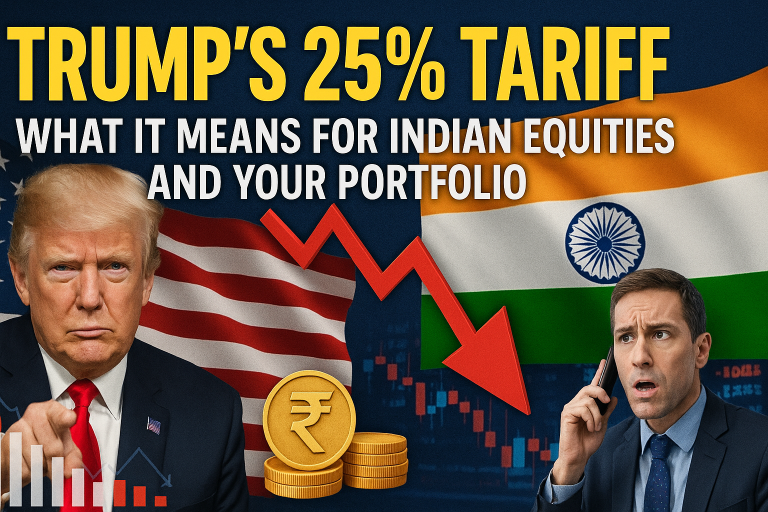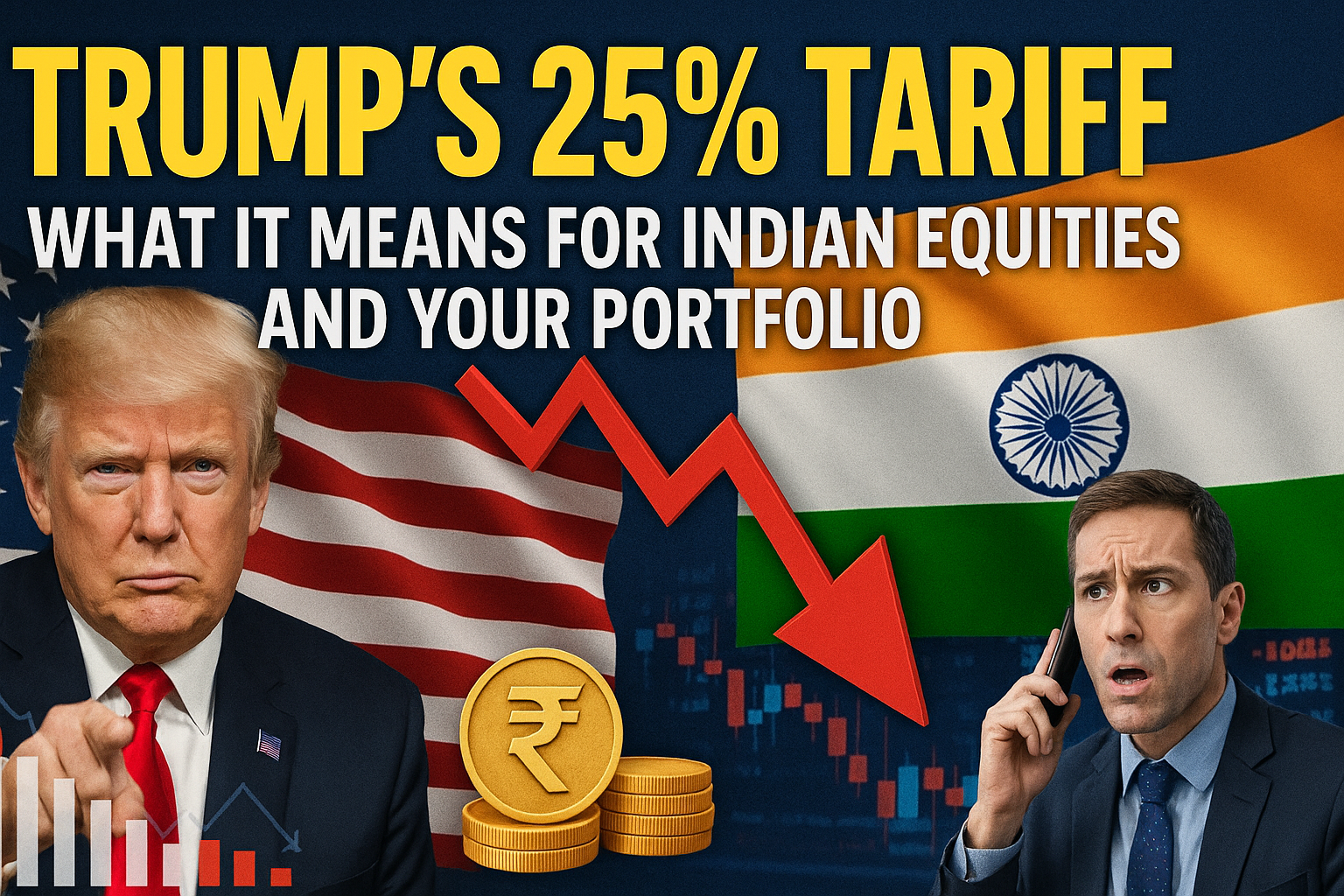Trump’s 25% Tariff: What It Means for Indian Equities and Your Portfolio

Understanding the 25% Tariff Move
Background of Trump’s Tariff Policies
Donald Trump is back in the headlines—and this time, he’s brandishing a 25% tariff against nations he claims are taking unfair advantage of American markets. India, with its massive export economy, has found itself squarely in the crosshairs. This isn’t just about trade—it’s a calculated geopolitical gambit that could upend market momentum across continents.
What Sectors Are Targeted?
We’re not talking about small potatoes. The new tariff wave threatens sectors like automobiles, steel, textiles, and generic pharmaceuticals—all vital to India’s export engine. The message? Compete at America’s price or get priced out.
Implications on Global Trade Dynamics
This isn’t a one-off—it’s part of a broader protectionist shift. Think U.S.-China trade war, now with a South Asian sequel. For India, it’s not just a hit to trade margins—it’s a wake-up call to diversify alliances, markets, and manufacturing bases.
Immediate Market Reactions in India
Stock Market Volatility Post-Announcement
When news of the tariff broke, Indian indices like Sensex and Nifty 50 didn’t just dip—they wobbled under investor panic. Export-heavy firms saw immediate sell-offs. The market smelled risk—and responded with a mini flight.
Sector-Wise Reactions: IT, Pharma, and Metals
- IT Stocks: Relatively unscathed; software remains a service-heavy export with minimal tariff implications.
- Pharma: Some pain expected in the generic drug segment headed to the U.S., but India’s diverse customer base offers a cushion.
- Metals: Bloodbath. Steel and aluminum exporters bore the brunt, with some stocks losing over 5% in a single trading day.
Impact on the Rupee and Foreign Exchange
As investor sentiment turned skittish, the rupee weakened against the dollar. Currency markets anticipate capital flight if U.S.-India tensions escalate, and that puts pressure on the RBI and fiscal policy.
Long-Term Impacts on Indian Equities
Export-Driven Companies at Risk
Tariffs squeeze margins. If Indian exporters can’t pass on the cost or pivot to other markets, profits and share prices could nosedive. This spells trouble for giants in the auto and metals sectors.
Opportunities for Domestic-Focused Firms
Here’s the silver lining: companies with a strong India-first revenue model—in FMCG, infra, and banking—could become new investor favorites.
Changes in FDI and Institutional Investment Flows
Uncertainty is poison to foreign investors. The knee-jerk response? Cautious FDI, trimmed exposure to volatile sectors, and a tilt toward “India-for-India” plays.
Portfolio Strategy: What Should Investors Do?
Diversification Across Geographies
Don’t put all your rupees in one basket. Look to diversify into emerging Asia, Europe, and domestic ETFs that avoid U.S. friction zones.
Hedging Against Tariff Risks
Consider gold, sovereign bonds, and currency-hedged mutual funds. These assets act as fire blankets when geopolitical sparks fly.
Tactical vs Strategic Portfolio Allocation
Tactical moves now can shield you—think rotating into utilities or consumer staples. Strategic allocation, however, means thinking 5-10 years out: who will thrive in an inward-looking world?
Sectoral Winners and Losers
Beneficiaries in the Auto and Textile Sector
Some Indian textile firms may pivot toward Europe and ASEAN markets, leveraging favorable trade deals. Auto ancillaries focused on local markets could also benefit from “import substitution” sentiments.
Likely Underperformers: Steel and Chemicals
Steel exporters are the biggest losers here—no two ways about it. And chemical firms, especially those in agro-exports to the U.S., may struggle with sudden demand cliffs.
Hidden Gems: Midcaps with Domestic Exposure
Watch out for midcaps in logistics, healthcare, and rural infrastructure—they’re immune to tariff drama and are underpriced right now.
Expert Opinions and Analyst Forecasts
What Indian Economists Are Saying
Top economists are urging calm. While there’s short-term damage, India’s resilient consumption story and manufacturing pivot could soften the blow.
Global Ratings and Predictions
Agencies like Moody’s are eyeing marginal downgrades for Indian exporters but maintain a stable outlook for the broader economy—especially with elections and policy reforms on the horizon.
Investor Sentiment Analysis
Retail investors are nervous. But institutional players are already sniffing around for undervalued assets in tariff-proof zones like renewable energy and fintech.
Global Trade War: A New Normal?
Parallels with the 2018 US-China Trade War
Sound familiar? It should. In 2018, the U.S.-China trade war tanked markets, froze global supply chains, and forced investors into survival mode. Trump’s 25% tariff on India is déjà vu with a desi twist. Same playbook. Different target.
Geopolitical and Economic Ripple Effects
Every tariff triggers a tremor. A 25% blow to Indian exports could stress trade corridors, increase supply chain complexity, and push India toward stronger ties with ASEAN, Africa, and the EU. The age of one-market dependency is over.
India’s Diplomatic and Strategic Stance
India isn’t sitting idle. Expect behind-the-scenes pressure on Washington and WTO appeals. But New Delhi also has cards to play—energy deals, defense contracts, and tech cooperation could become bargaining chips.
Government Response and Policy Moves
Trade Negotiation Tactics
India may push for sector-specific relief or “tariff phase-outs” as part of trade talks. Quiet diplomacy, backed by data on mutual benefits, could work better than loud retaliation.
Tariff Countermeasures from India
If pressure mounts, India could respond in kind—maybe a mirror tariff on select American goods like farm equipment or tech parts. But retaliatory moves are tricky in an election year.
Economic Stimulus and Sectoral Support
The government may roll out export incentives, bolster MSME funding, or expand the PLI scheme to absorb some of the tariff shock.
Impact on Retail Investors

How Mutual Funds Are Responding
Fund managers are already rotating out of tariff-hit sectors and reallocating to banking, consumer goods, and infra. Themes like domestic resilience and rural growth are hot again.
Effect on SIPs and Long-Term Goals
SIP investors: this is your stress test. Stay invested, but rebalance if your fund is overexposed to U.S.-facing companies. Time in the market still beats timing the market—especially in times like these.
Financial Planning Amid Global Uncertainty
Revisit your financial goals. Is your plan inflation-proof? Are you diversified enough? Add a layer of protection via debt funds, liquid cash reserves, and maybe even some international ETFs.
Opportunities in the Chaos
Investing in Gold and Safe Havens
Gold loves fear. The more uncertain the market, the shinier it becomes. Add gold ETFs, sovereign bonds, or even digital gold as portfolio anchors.
Rise of ESG and Local Manufacturing Themes
Sectors that align with “Atmanirbhar Bharat” (self-reliant India) are looking bullish—think solar, EVs, sustainable agriculture. ESG is more than a buzzword—it’s becoming a safe-harbor strategy.
Niche ETFs and Thematic Mutual Funds
Betting on chaos? There’s an ETF for that. Look into infrastructure, manufacturing, or smallcap ETFs targeting domestic revival stories.
Comparing Past Trade Tensions

Historical Case Studies and Lessons Learned
Every tariff storm has passed eventually. U.S.-Japan (1980s), U.S.-China (2018)—they all triggered short-term losses, followed by agile reallocations and massive comebacks. Indian investors need to learn, not flee.
Market Recovery Timelines and Investment Trends
Historically, sectors hit hardest bounce back the fastest—once clarity returns. The real winners? Those who bought low, stayed calm, and looked beyond the noise.
Economic Indicators to Watch
Track the Current Account Deficit (CAD), RBI’s stance on interest rates, and foreign investment trends. These are your compass through the fog.
Tariff Impact on Startups and MSMEs
Challenges with Export Barriers
Smaller businesses with U.S.-focused products are already tightening belts. Many lack the buffers big corporations have. Expect delays in orders, shrinking margins, and rising loan defaults.
New Incentives for Domestic Consumption
On the flip side, many MSMEs are discovering a new goldmine: domestic demand. Schemes like Make in India, Digital India, and e-commerce integration are offering new lifelines.
Innovation and Resilience in Indian SMEs
India’s startup and MSME sectors are fast learners. From pivoting to new markets to reengineering product lines, they’re doing what giants can’t: adapting on the fly.
Investor Psychology and Behavioral Trends

The Fear-Greed Index Reaction
We’re firmly in “fear” territory right now. The index shows caution, if not outright panic. But contrarians know—fear is the fuel of opportunity.
Herd Mentality vs Contrarian Investing
Following the crowd means buying high and selling low. A contrarian move—like buying into a domestic infrastructure fund right now—might seem crazy but could be brilliant.
The Role of Financial Advisors
In uncertain times, pros shine. A seasoned financial advisor can help craft a bulletproof portfolio strategy, keep emotions out of the game, and find gems where others see gloom.
Risk Management and Scenario Planning
Building a Contingency Plan for Portfolios
Your portfolio needs an emergency escape hatch. Maintain a 15-20% buffer in safe assets, and prep for at least two scenarios: tariff escalation and de-escalation.
Simulation of High-Tariff Environments
Backtest your portfolio using scenarios from past trade wars. If your holdings can’t survive 2018-level stress, it’s time to reallocate.
Rebalancing Amid Economic Headwinds
Quarterly rebalancing is no longer optional—it’s essential. Adjust exposure based on real-time geopolitical risk and macro signals.
Tools and Resources for Investors
Top Tariff-Tracking Sites and Data Feeds
- WTO.org for legal updates
- USTR.gov for U.S. policy
- TradingEconomics.com for live tariff trackers
Must-Have Apps and Financial Calculators
- Kuvera and Groww for mutual fund tracking
- Tickertape for stock valuation
- Coin by Zerodha for SIPs
Follow Influential Market Experts
- Ruchir Sharma (macro genius)
- Nilesh Shah (domestic strategy)
- Saurabh Mukherjea (smallcap master
FAQs
- What is Trump’s 25% tariff about?
It’s a fresh wave of trade restrictions aimed at reducing U.S. imports from key exporting nations like India. - Which Indian sectors will suffer most?
Steel, textiles, auto, and chemical exports are expected to take the biggest hit due to their U.S. dependency. - Should I sell off my U.S.-facing stocks?
Not blindly. Reallocate gradually. Look for companies with pricing power or alternative markets. - Can Indian government measures help?
Yes—through trade negotiations, incentives, and expanded domestic demand. - Are there any short-term opportunities?
Yes. Gold, ESG stocks, and domestic infrastructure plays are gaining investor traction. - What does this mean for long-term investors?
A buying opportunity in disguise—if you can stomach the short-term volatility and stay focused on fundamentals.
Conclusion: The Road Ahead for Indian Investors
Markets hate uncertainty. But investors who can see past the smoke and tariffs stand to benefit. Trump’s 25% move may be disruptive, but it also accelerates a deeper, more self-reliant India—and opens up new frontiers for savvy investors. Whether you’re a SIP warrior, swing trader, or long-term believer, the key is the same: stay informed, stay calm, and stay invested—but stay sharp.







